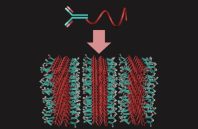Exploiting a process known as molecular self-assembly, MIT chemical engineers have built three-dimensional arrays of antibodies that could be used as sensors to diagnose diseases such as malaria or tuberculosis. These sensors, which contain up to 100 stacked layers of antibodies, offer much more sensitivity than existing antibody-based sensors, which have only a single layer of antibodies.
3-D Antibody Arrays Offer Better Sensing


 (585) 768-2513
(585) 768-2513
